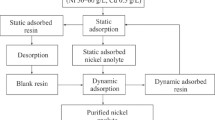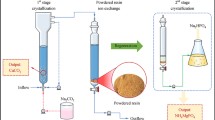Abstract
Effective recovery of high-value heavy metals from electroplating wastewater is of great significance, but recovering nickel ions from real electroplating wastewater as nickel sheet has not been reported. In this study, the pilot-scale fixed-bed resin adsorption was conducted to recover Ni(II) ions from real nickel plating wastewater, and then the concentrated Ni(II) ions in the regenerated solution were reduced to nickel sheet via electrodeposition. A commercial cation-exchange resin was selected and the optimal resin adsorption and regeneration conditions were investigated. The resin exhibited an adsorption capacity of 63 mg/g for Ni(II) ions, and the average amount of treated water was 84.6 bed volumes (BV) in the pilot-scale experiments. After the adsorption by two ion-exchange resin columns in series and one chelating resin column, the concentrations of Ni(II) in the treated wastewater were below 0.1 mg/L. After the regeneration of the spent resin using 3 BVof 4% (w/w) HCl solution, 1.5 BV of concentrated neutral nickel solution (>30 g/L) was obtained and used in the subsequent electrodeposition process. Using the aeration method, alkali and water required in resin activation process were greatly reduced to 2 BV and 3 BV, respectively. Under the optimal electrodeposition conditions, 95.6% of Ni(II) in desorption eluent could be recovered as the elemental nickel on the cathode. The total treatment cost for the resin adsorption and regeneration as well as the electrodeposition was calculated.

Similar content being viewed by others
References
Almazán-Ruiz F J, Caballero F V, Cruzdiaz M R, Rivero E P, Vazquezarenas J, Gonzalez I (2015). Nickel recovery from an electroplating rinsing effluent using RCE bench scale and RCE pilot plant reactors: The influence of pH control. Chemical Engineering Research & Design, 97: 18–27
Amblard J, Epelboin I, Froment M, Maurin G (1979). Inhibition and nickel electrocrystallization. Journal of Applied Electrochemistry, 9(2): 233–242
Azadi F, Saadat S, Karimi-Jashni A (2018). Experimental investigation and modeling of nickel removal from wastewater using modified rice husk in continuous reactor by response surface methodology. Civil Engineering (Shiraz), 42(3): 315–323
Chen C, Shih Y, Huang Y, Huang G (2011). Recovery of nickel with the addition of boric acid using an electrodeposition reactor. Desalination and Water Treatment, 32(1–3): 345–350
Cheremisinoff N P (2002). Chapter 10 — Ion exchange and carbon adsorption. In: Cheremisinoff N P, ed. Handbook of Water & Wastewater Treatment Technologies. Oxford: Butterworth-Heinemann, 372–445
Coman V, Robotin B, Ilea P (2013). Nickel recovery/removal from industrial wastes: A review. Resources, Conservation and Recycling, 73(73): 229–238
Davalos C E, Lopez J R, Ruiz H, Mendez A, Antano-Lopez R, Trejo G (2013). Study of the role of boric acid during the electrochemical deposition of Ni in a sulfamate bath. International Journal of Electrochemical Science, 8(7): 9785–9800
Dermentzis K (2010). Removal of nickel from electroplating rinse waters using electrostatic shielding electrodialysis/electrodeionization. Journal of Hazardous Materials, 173(1–3): 647–652
Dizge N, Keskinler B, Barlas H (2009). Sorption of Ni(II) ions from aqueous solution by Lewatit cation-exchange resin. Journal of Hazardous Materials, 167(1–3): 915–926
Eom T H, Lee C H, Kim J H, Lee C H (2005). Development of an ion exchange system for plating wastewater treatment. Desalination, 180(1–3): 163–172
Fu D, Cheng X (2018). On-site recycling technology for electroplating nickel-containing wastewater. Plating and Finishing, 40(1): 22–26
Gomathi Priya P, Ahmed Basha C, Ramamurthi V (2011). Removal of Ni(II) using cation exchange resins in packed bed column: prediction of breakthrough curves. Clean-Soil Air Water, 39(1): 88–94
Guan W, Tian S, Cao D, Chen Y, Zhao X (2017). Electrooxidation of nickel-ammonia complexes and simultaneous electrodeposition recovery of nickel from practical nickel-electroplating rinse waste-water. Electrochimica Acta, 246: 1230–1236
Hackbarth F V, Girardi F, Santos J C, De Souza A A, Boaventura R A, De Souza S M, Vilar V J (2015). Ion-exchange breakthrough curves for single and multi-metal systems using marine macroalgae Pelvetia canaliculata as a natural cation exchanger. Chemical Engineering Journal, 269: 359–370
Hernández-Tapia J R, Vazquez-Arenas J, González I (2013). Electrochemical reactor with rotating cylinder electrode for optimum electrochemical recovery of nickel from plating rinsing effluents. Journal of Hazardous Materials, 262: 709–716
Huang P, Zhang Y (2018). Electrodeposition of nickel coating in choline chloride-urea deep eutectic solvent. International Journal of Electrochemical Science, 13(11): 10798–10808
Iqbal M, Saeed A, Zafar S I (2009). FTIR spectrophotometry, kinetics and adsorption isotherms modeling, ion exchange, and EDX analysis for understanding the mechanism of Cd2+ and Pb2+ removal by mango peel waste. Journal of Hazardous Materials, 164(1): 161–171
** R J, Peng C S, Abou-Shady A, Zhang K D (2012). Recovery of precious metal material Ni from nickel containing wastewater using electrolysis. Applied Mechanics and Materials, 164: 263–267
Juang R S, Kao H C, Chen W (2006). Column removal of Ni(II) from synthetic electroplating waste water using a strong-acid resin. Separation and Purification Technology, 49(1): 36–42
Leinonen H, Lehto J, Mäkelä A (1994). Purification of nickel and zinc from waste waters of metal-plating plants by ion exchange. Reactive Polymers, 23(2–3): 221–228
Li H, Zhang H, Long J, Zhang P, Chen Y (2019). Combined Fenton process and sulfide precipitation for removal of heavy metals from industrial wastewater: Bench and pilot scale studies focusing on in-depth thallium removal. Frontiers of Environmental Science & Engineering, 13(4): 49
Li T, Zhang W, Zhai S, Gao G, Ding J, Zhang W, Liu Y, Zhao X, Pan B, Lv L (2018). Efficient removal of nickel(II) from high salinity wastewater by a novel PAA/ZIF-8/PVDF hybrid ultrafiltration membrane. Water Research, 143: 87–98
Liang H, **ao K, Wei L, Yang B, Yu G, Deng S, Duan H, Zhu C, Li J, Zhang J (2019). Decomplexation removal of Ni(II)-citrate complexes through heterogeneous Fenton-like process using novel CuO-CeO2-CoOx composite nanocatalyst. Journal of Hazardous Materials, 374: 167–176
Lin L C, Li J K, Juang R S (2008). Removal of Cu(II) and Ni(II) from aqueous solutions using batch and fixed-bed ion exchange processes. Desalination, 225(1–3): 249–259
Lu J, Cao L, Zhou H, Tu Y, Liu W (2013). Study on treatment of nickel-containing electroplating wastewater by ion exchange method. Industrial Safety and Environmental Protection, 39(12): 13–15
Ma A, Abushaikha A, Allen S J, Mckay G (2019). Ion exchange homogeneous surface diffusion modelling by binary site resin for the removal of nickel ions from wastewater in fixed beds. Chemical Engineering Journal, 358: 1–10
Marder L, Ortega Navarro E M, Pérez-Herranz V, Bernardes A M, Ferreira J Z (2009). Chronopotentiometric study on the effect of boric acid in the nickel transport properties through a cation-exchange membrane. Desalination, 249(1): 348–352
Mazur L P, Pozdniakova T A, Mayer D A, Boaventura R A R, Vilar V J P (2016). Design of a fixed-bed ion-exchange process for the treatment of rinse waters generated in the galvanization process using Laminaria hyperborea as natural cation exchanger. Water Research, 90:354–368
Mazur L P, Pozdniakova T A, Mayer D A, de Souza S M A G U, Boaventura R A R, Vilar V J P (2017). Cation exchange prediction model for copper binding onto raw brown marine macro-algae Ascophyllum nodosum: Batch and fixed-bed studies. Chemical Engineering Journal, 316: 255–276
OECD (2004). Emission Scenario Document on Metal Finishing: OECD Environmental Health and Safety Publications. Paris: OECD
Orhan G, Arslan C, Bombach H, Stelter M (2002). Nickel recovery from the rinse waters of plating baths. Hydrometallurgy, 65(1): 1–8
Rahman M L, Sarkar S M, Yusoff M M (2016). Efficient removal of heavy metals from electroplating wastewater using polymer ligands. Frontiers of Environmental Science & Engineering, 10(2): 352–361
Revathi M, Saravanan M, Chiya A B, Velan M (2012). Removal of copper, nickel, and zinc ions from electroplating rinse water. Acta Hydrochimica et Hydrobiologica, 40(1): 66–79
Shaidan N H, Eldemerdash U, Awad S (2012). Removal of Ni(II) ions from aqueous solutions using fixed-bed ion exchange column technique. Journal of the Taiwan Institute of Chemical Engineers, 43(1): 40–45
Šupicová M, Rozik R, Trnkova L, Oriňakova R, Galova M (2006). Influence of boric acid on the electrochemical deposition of Ni. Journal of Solid State Electrochemistry, 10(2): 61–68
Verbeken K, Pattyn S, Clercq J, Verhaege M (2007). Recovery of Nickel from Diluted Solutions by Resin Mediated Electrodeposition. Dusseldorf: GDMB Medienverlag, 1–9
Zhang B, Liao S, **e H, Zhang H (2014). Progress of electroless amorphous and nano alloy deposition: A review—Part 2. Transactions of the Institute of Metal Finishing, 92(2): 74–80
Zhao X, Guo L, Hu C, Liu H, Qu J (2014). Simultaneous destruction of Nickel (II)-EDTA with TiO2/Ti film anode and electrodeposition of nickel ions on the cathode. Applied Catalysis B: Environmental, 144: 478–485
Zhu L, Wang J, **ong Z, Guo Q, Zhang W, Sun P (2016). Design and optimization of pretreatment process for nickel containing waste-water from an electroplating plant. Water Treatment Technology, 4: 133–135
Acknowledgements
This work was supported by Major Science and Technology Program for Water Pollution Control and Treatment (No. 2017ZX07202001) for financial support.
Author information
Authors and Affiliations
Corresponding author
Additional information
Highlights
• Resin adsorption and subsequent electrodeposition were used for nickel recovery.
• Treated wastewater can meet the Electroplating Pollutant Discharge Standard.
• The spent resin is completely regenerated by 3 BV of 4% HCl solution.
• 95.6% of nickel in concentrated eluent was recovered by electrodeposition.
Electronic supplementary material
Rights and permissions
About this article
Cite this article
Li, T., **ao, K., Yang, B. et al. Recovery of Ni(II) from real electroplating wastewater using fixed-bed resin adsorption and subsequent electrodeposition. Front. Environ. Sci. Eng. 13, 91 (2019). https://doi.org/10.1007/s11783-019-1175-7
Received:
Revised:
Accepted:
Published:
DOI: https://doi.org/10.1007/s11783-019-1175-7




